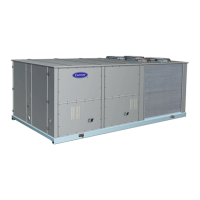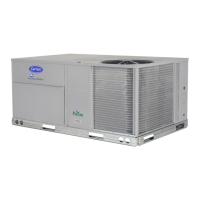32
PRE-START-UP
Proceed as follows to inspect and prepare the unit for initial start-
up:
1. Remove all access panels.
2. Read and follow instructions on all WARNING, CAUTION,
and INFORMATION labels attached to, or shipped with,
unit.
3. Make the following inspections:
a. Inspect for shipping and handling damages such as bro-
ken lines, loose parts, or disconnected wires, etc.
b. Inspect for oil at all refrigerant tubing connections and
on unit base. Detecting oil generally indicates a refriger-
ant leak. Leak-test all refrigerant tubing connections
using electronic leak detector, halide torch, or liquid-
soap solution.
c. Inspect all field-wiring and factory-wiring connections.
Be sure that connections are completed and tight. Be
sure that wires are not in contact with refrigerant tubing
or sharp edges.
d. Inspect coil fins. If damaged during shipping and han-
dling, carefully straighten fins with a fin comb.
4. Verify the following conditions:
a. Make sure that condenser-fan blade are correctly posi-
tioned in fan orifice. See Condenser-Fan Adjustment
section for more details.
b. Make sure that air filter(s) is in place.
c. Make sure that condensate drain trap is filled with water
to ensure proper drainage.
d. Make sure that all tools and miscellaneous loose parts
have been removed.
START-UP, GENERAL
Unit Preparation
Make sure that unit has been installed in accordance with installa-
tion instructions and applicable codes.
Gas Piping
Check gas piping for leaks.
Return-Air Filters
Make sure correct filters are installed in unit (see Appendix B -
Physical Data). Do not operate unit without return-air filters.
WARNING
PERSONAL INJURY HAZARD
Failure to follow this warning could result in personal injury or
death.
1. Follow recognized safety practices and wear approved
Personal Protective Equipment (PPE), including safety
glasses and gloves when checking or servicing refrigerant
system.
2. Do not use a torch to remove any component. System
contains oil and refrigerant under pressure. To remove a
component, wear PPE and proceed as follows:
a. Shut off all electrical power to unit. Apply applicable
lockout/tag-out procedures.
b. Recover refrigerant to relieve all pressure from sys-
tem using both high-pressure and low pressure ports.
c. Do not use a torch. Cut component connection tubing
with tubing cutter and remove component from unit.
d. Carefully un-sweat remaining tubing stubs when
necessary. Oil can ignite when exposed to torch
flame.
3. Do not operate compressor or provide any electric power
to unit unless compressor terminal cover is in place and
secured.
4. Do not remove compressor terminal cover until all electri-
cal power is disconnected and approved lockout/tag-out
procedures are in place.
5. Relieve all pressure from system before touching or dis-
turbing anything inside terminal box whenever refriger-
ant leak is suspected around compressor terminals.
6. Never attempt to repair a soldered connection while
refrigerant system is under pressure.
WARNING
ELECTRICAL OPERATION HAZARD
Failure to follow this warning could result in personal injury or
death.
The unit must be electrically grounded in accordance with lo-
cal codes and NEC ANSI/NFPA 70 (American National Stan-
dards Institute/National Fire Protection Association).
WARNING
PERSONAL INJURY AND ENVIRONMENTAL
HAZARD
Failure to follow this warning could cause personal injury or
death.
Relieve pressure and recover all refrigerant before system
repair or final unit disposal.
Wear safety glasses and gloves when handling refrigerants.
Keep torches and other ignition sources away from
refrigerants and oils.
WARNING
FIRE, EXPLOSION HAZARD
Failure to follow this warning could result in death, serious
personal injury and/or property damage.
Disconnect gas piping from unit when pressure testing at pres-
sure greater than 0.5 psig (3450 Pa). Pressures greater than
0.5 psig will cause gas valve damage resulting in hazardous
condition. If gas valve is subjected to pressure greater than
0.5 psig, it must be replaced before use. When pressure testing
field-supplied gas piping at pressures of 0.5 psig or less, a unit
connected to such piping must be isolated by closing the man-
ual gas valve(s).

